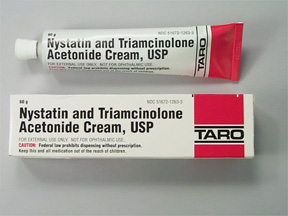
Nystatin-triamcinolone Coupons & Savings Card – Discount Prices from $9.24
My prescription
Edit
15GM of 100000-0.1UNIT/GM-%, Nystatin-triamcinolone (1 Tube)
Select pharmacy

CVS
$19.64
COUPON PRICE
Walmart
$9.24
COUPON PRICE
Walgreens
$15.00
COUPON PRICE
Albertsons
$19.46
COUPON PRICEFree Nystatin-triamcinolone Savings Card

Walmart
$9.24
Show this coupon to your pharmacist
ID
LH01BAD7EA
PCN
CHIPPO
BIN
019876
GRP
LHX
This coupon is not insurance
Nystatin-triamcinolone dosage forms
Dosage Quantity Price from Per unit 15GM of 100000-0.1UNIT/GM-% 1 Tube $9.24 $9.24 15GM of 100000-0.1UNIT/GM-% 2 Tubes $15.98 $7.99 15GM of 100000-0.1UNIT/GM-% 3 Tubes $22.72 $7.57
| Dosage | Quantity | Price from | Per unit |
|---|---|---|---|
| 15GM of 100000-0.1UNIT/GM-% | 1 Tube | $9.24 | $9.24 |
| 15GM of 100000-0.1UNIT/GM-% | 2 Tubes | $15.98 | $7.99 |
| 15GM of 100000-0.1UNIT/GM-% | 3 Tubes | $22.72 | $7.57 |
Nystatin-triamcinolone Warnings
Here is essential safety and warning information regarding the use of nystatin/triamcinolone. It is crucial to understand these details and discuss any concerns with a healthcare professional.
Allergic Reactions: If you have previously experienced an allergic reaction to nystatin or triamcinolone, inform your dermatologist prior to using this medication. Be vigilant for symptoms of an allergic response, such as skin swelling, rash, itching, or other irritations. Discontinue use and contact your dermatologist if these symptoms occur. Seek immediate medical assistance if you experience severe swelling or difficulty breathing.
Adrenal Gland Function Changes: Triamcinolone, a component of this medication, is a topical steroid. Prolonged use over large skin areas can occasionally lead to adrenal suppression, where the adrenal gland reduces hormone production due to reliance on the medication. Abrupt cessation of triamcinolone can result in serious side effects. Increased risk factors include using high-potency topical steroids, prolonged use of nystatin/triamcinolone, excessive application, covering the treated area with a bandage, and use in young children.
By adhering to these guidelines and consulting with your healthcare provider, you can use nystatin/triamcinolone safely and effectively.
Nystatin-triamcinolone Side Effects
Common side effects:
- burning
- itching
- irritation
- dryness
Less common but important to monitor:
- inflamed hair follicles
- excessive or unwanted hair growth
- acne-like bumps
- changes in skin color
- rashes
- skin thinning
- stretch marks
- heat rash
Serious side effects:
- unusual or extreme tiredness
- weight loss
- headaches
- swelling of the ankles or feet
- increased thirst or urination
- vision problems
- serious allergic reaction
Nystatin-triamcinolone Interactions
Nystatin and Triamcinolone is a combination medication used to treat fungal skin infections by combining an antifungal agent with a corticosteroid to reduce inflammation. While this topical treatment is generally safe, it's important to be aware of potential interactions and precautions.
Drug Interactions:
Topical nystatin and triamcinolone is primarily applied to the skin and has minimal systemic absorption, which reduces the likelihood of significant drug interactions. However, if used over large areas, for prolonged periods, or under occlusive dressings, increased absorption may occur, potentially leading to interactions with other medications. For instance, corticosteroids can affect blood sugar levels, so individuals with diabetes should monitor their glucose levels closely during treatment. Additionally, using this medication alongside other corticosteroids or drugs that suppress the immune system may enhance systemic effects, increasing the risk of side effects.
Food and Lifestyle Interactions:
While topical application limits systemic exposure, it's advisable to be cautious with certain foods and beverages. For example, consuming large amounts of grapefruit or grapefruit juice can interfere with the metabolism of corticosteroids, potentially increasing their effects. Therefore, it's recommended to limit grapefruit intake during treatment.
Disease Interactions:
Certain medical conditions may influence the safety and effectiveness of nystatin and triamcinolone:
Diabetes: Corticosteroids can elevate blood sugar levels. Individuals with diabetes should use this medication cautiously and monitor their glucose levels regularly.
Infections: Corticosteroids may suppress the immune response, potentially worsening existing infections or increasing susceptibility to new infections. It's important to inform your healthcare provider of any current infections before starting treatment.
Ocular Conditions: Prolonged use of corticosteroids can lead to increased intraocular pressure, potentially causing glaucoma or cataracts. If you have a history of eye conditions, discuss this with your doctor prior to using the medication.
General Precautions:
Application Area: Avoid using the medication on the face, groin, or underarms unless directed by a healthcare provider, as these areas are more susceptible to side effects.
Occlusive Dressings: Do not cover the treated area with bandages or other coverings unless instructed by your doctor, as this can increase absorption and the risk of side effects.
Duration of Use: Use the medication for the full prescribed duration, even if symptoms improve earlier. Do not use it for longer than recommended, as prolonged use can lead to skin thinning and other side effects.
Always inform your healthcare provider about all medications, supplements, and underlying health conditions before starting nystatin and triamcinolone to ensure safe and effective use.
